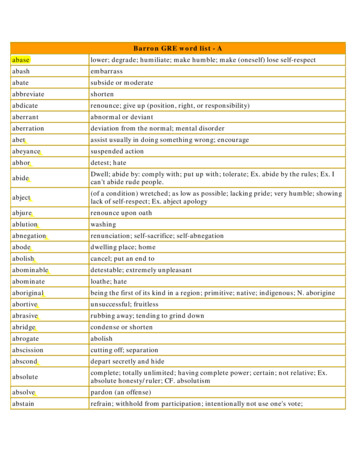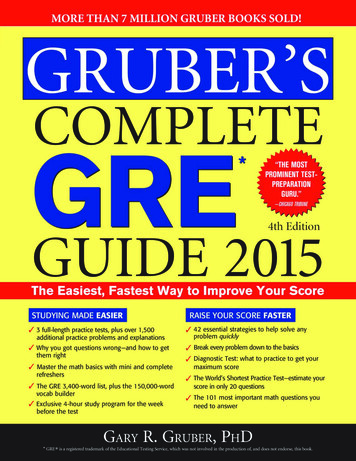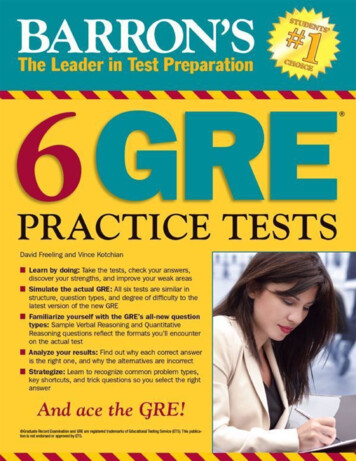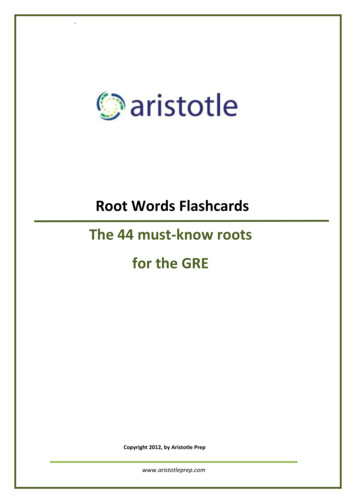
Transcription
GRE EXAMMath WorkbookSeventh Edition2
Table of ContentsUpdates to the GREHow to Use This BookPART ONE: GETTING STARTEDChapter 1 Introduction to GRE MathPART TWO: MATH CONTENT REVIEWChapter 2 ArithmeticChapter 3 AlgebraChapter 4 GeometryPART THREE: QUESTION TYPE REVIEWChapter 5 Quantitative ComparisonsChapter 6 Word ProblemsChapter 7 Data InterpretationsA Note for International StudentsOther Kaplan Titles on Graduate School Admissions3
Updates to the GREInstead of one major overhaul as originally planned, ETS will introduce revisionsto the GRE gradually, beginning with two new question types-one math, one verbal-thatwere introduced into the computer-based GRE in November 2007. On Test Day, you maysee just one sample of the new math question type, just one sample of the new verbalquestion type, OR you won’t see either question at all. For the time being, these newquestion types do not count toward your score. As of this printing, ETS has notannounced a timeline for when these new types will count toward your score.NEW QUANTITATIVE QUESTION TYPE-NUMERIC ENTRYEssentially, the Numeric Entry question type does not provide any answer choicesat all. None. Zip. Zero! You have to do the math, work out your answer and type it in thebox provided. The most important thing to keep in mind here is to read through thequestion very carefully; make sure you know exactly what’s being asked of you. Thencheck your work just as carefully. Here’s a sample Numeric Entry question and answerexplanation.The health club charges 35 per month plus 2.50 for each aerobic classattended. How many aerobic classes were attended for the month if the totalmonthly charge was 52.50?Click on the answer box, and then type in a number.Use backspace to erase.Answer: 7Translate the situation into an algebraic equation, and then solve for the unknownvariable. We are asked to find the number of classes attended; assign the variable x torepresent the number of aerobics classes attended. The monthly fee is 35, plus 2.50 forevery class attended, or 2.5 times x (the number of classes).So the equation is 35 2.5x 52.50, where x equals the number of aerobicclasses attended. Subtract 35 from both sides of the equation: 2.5x 17.5. Divide bothsides by 2.5, and x 7STAY ON TOP OF THE LATEST DEVELOPMENTSAs ETS makes further announcements, you can depend on Kaplan to provide youwith the most accurate, up-to-the-minute information. You can get updates by visiting usat Kaptest.com/NEWGRE.Good Luck!4
How To Use This BookKaplan has prepared students to take standardized tests for more than 50 years.Our team of researchers know more about preparation for the GRE than anyone else, andyou’ll find their accumulated knowledge and experience throughout this book. The GREis a standardized test, and so, every test covers the same content in roughly the same way.This is good news for you; it means that the best way to prepare is to focus on the sort ofquestions you are likely to see on Test Day. The main focus of this book is on strategicreviews, exercises, and practice tests with explanations that will help you brush up on anymath skills you may have forgotten. If possible, work through this book a little at a timeover the course of several weeks. There is a lot of math to absorb, and it’s hard to do it allat once.STEP 1: THE BASICSIn Part One of this book, “Getting Started,” we’ll provide you with backgroundinformation on the quantitative section of the test, what it covers, and how it’s organized.STEP 2: MATH CONTENT REVIEWOnce you have the big picture, focus on the content. Part Two of this book, “MathContent Review,” gives you a complete tour of the math that you will see on Test Day.The material in the math content review is divided into particular subjects. Each subjectbegins with a review, followed by practice questions organized by level of difficulty.This structure makes it easy for you to pinpoint the math concepts you need to review andquickly get your skills up to speed.We suggest that you quickly skim the content review that introduces a section andthen try the exercise. If you find difficult, go back to the content review before movingon. If you do well on the exercise, try the basic problem set that follows it. Once you feelthat you have a good grasp on the basics of this subject, try the intermediate andadvanced problem sets. Answers and explanations for the practice problems appear at theend of the chapter. Read the explanations to all the questions-even those you got right.Often the explanations will contain strategies that show you how you could have gottento the answer more quickly and efficiently.STEP 3: BECOME FAMILIAR WITH GRE QUESTION TYPESThe GRE contains three main question types: Quantitative Comparisons, WordProblems, and Data Interpretation. Part Three of this book covers these types withstrategies and sample questions. Your focus here should be to familiarize yourself withthe question types so you won’t be trying to figure out how to approach them on TestDay.Now you’re ready to begin preparing for the math section of the GRE. Good luck!5
PART ONE Getting StartedChapter 1Introduction to GRE MathIf you’re considering applying to graduate school, then you’ve already seen all themath you need for the GRE—in junior high. The only problem is, you may not have seenit lately. When was the last time you had to add a bunch of fractions without a calculator?The math that appears on the GRE is almost identical to the math tested on the SAT orACT. You don’t need to know trigonometry. You don’t need to know calculus.No matter how much your memories of junior high algebra classes have dimmed,don’t panic. The GRE tests a limited number of core math concepts in predictable ways.Certain topics come up in every test, and, chances are, these topics will be expressed inmuch the same way; even some of the words and phrases appearing in the questions arepredictable. Since the test is so formulaic, we can show you the math you’re bound toencounter. Practice on test—like questions, such as those in the following chapters, willprepare you for the questions you will see on the actual test.Here is a checklist of core math concepts you’ll need to know for the GRE. Theseconcepts are vital, not only because they are tested directly on every GRE, but alsobecause you need to know how to perform these simpler operations in order to performmore complicated tasks. For instance, you won’t be able to find the volume of a cylinderif you can’t find the area of a circle. We know the math operations on the following listare pretty basic, but make sure you know how to do them.GREMATH BASICSAdd, subtract multiply and divide fractions. (Chapter 2)Convert fractions to decimals, and vice versa. (Chapter 2)Add, subtract multiply, and divide signed numbers. (Chapter 2)Plug numbers into algebraic expressions. (Chapter 3)Solve a simple algebraic equation. (Chapter 3)Find a percent using the percent formula. (Chapter 2)Find an average. (Chapter 2)Find the areas of rectangles, triangles, and circles. (Chapter 5)HOW MATH IS SCORED ON THE GREThe GRE will give you a scaled quantitative score from 200 to 800. (The averagescore is 575.) This score reflects your performance on the math portion of the GREcompared to all other GRE test takers.6
UNDERSTANDING THE QUANTITATIVE SECTIONIn the Quantitative section, you’ll have 45 minutes to complete 28 questions,which consist of three question types: Quantitative Comparisons, Word Problems, andData Interpretation.The chart below shows how many questions you can expect of each question type,as well as the amount of time you should spend per question on each question type, veryroughly speaking.Overview of the Quantitative Section Question TypesAs someone famous once said, “Know thine enemy.” You need to know firsthandthe way this section of the test is put together if you want to take it apart.Word ProblemsIn the Quantitative section on the GRE, you will have to solve problems that test avariety of mathematical concepts. Word Problems typically deal with core math concepts:percentages, simultaneous equations, symbolism, special triangles, multiple and oddballfigures, combinations and permutations, standard deviation, mean, median, mode, range,and probability.You can expect about 10 Word Problems. As with other question types, the morequestions you get right, the harder the questions you will see.Strategies, and sample questions can be found in Chapter 5.Quantitative ComparisonsOn Quantitative Comparisons, or QCs, as we like to call them, instead of solvingfor a particular value, your job is to compare two quantities. At first, these questions tendto throw test—takers because of their unique format. But once you become used to them,they should actually take less time to solve than other math question types.Doing well on QCs begins with understanding what makes them different fromother math questions. The difficulty of the QCs will depend on how well you are doing inthe section. In each question, you’ll see two mathematical expressions. One is in Column7
A, the other in Column B. Your job is to compare them. Some questions includeadditional information about one or both quantities. This information is centered, and isessential to making the comparison.Strategies and sample questions for QCs can be found in Chapter 6.Data InterpretationData Interpretation questions are statistics—oriented. You will likely be presentedwith a set of tables, charts, or graphs, which are followed by three to five questions.Strategies and sample questions can be found in Chapter 7.BACKDOOR STRATEGIESSometimes applying common sense or backdoor strategies will get you to thecorrect answer more quickly and easily. The key is to be open to creative approaches.Often this involves taking advantage of the question format. These three methods areextremely useful when you don’t see—or would rather not use—the textbook approach tosolving a question.Picking NumbersPicking numbers is a handy strategy for “abstract” problems—ones usingvariables either expressed or implied—rather than numbers. An expressed variableappears in the question (“Jane had x apples and 3 oranges ”). Questions with impliedvariables describe a problem using just numbers, but the only way to solve the problem isby setting up an equation that uses variables.Problems that lend themselves to the picking numbers strategy involve simplemath, but the variables make the problem complex. They include those where both thequestion and the answer choices have variables, expressed or implied; where the problemtests a number property you don’t recall; or where the problem and the answer choicesdeal with percents or fractions.Step 1. Pick Simple NumbersThese will stand in for the variables.Step 2. Try Them OutTry out all the answer choices using the numbers you picked, eliminating thosethat gave you a different result.Step 3. Try Different Values8
If more than one answer choice works, use different values and start again.BacksolvingSome math problems don’t have variables that let you substitute picked numbers,or they require an unusually complex equation to find the answer. In cases like these, trybacksolving: Simply plug the given answer choices back into the question until you findthe one that works. Unfortunately, there are no hard—and—fast rules that identify apicking numbers question from a backsolving problem. You have to rely on two things:The experience you gain from answering practice questions, and your instinct.Combining these two skills will point you to the fastest solution for answering a problem.If you do this using the system outlined below, it shouldn’t take long.Step 1. Estimate Whether the Answer Will Be Small or LargeEyeball the question and predict whether the answer will be small or large. Yourestimate needn’t (and shouldn’t) be precise; it just has to reflect your “feel” for therelative size of the answer.Step 2. Start with B or DFor small—quantity answers, start backsolving with answer choice B; forlarge—quantity answers, start with D. By starting with B or D, you have a 40% chance ofgetting the correct answer in a single try because GRE answers are listed in order ofascending size. For example, if you start with B, you have these three possibilities: B isright, A is right (because B is too big), or B is too small.Step 3. Test the Choice That You Did Not Start WithIf B is too small or D is too large, you’ll have three choices left. In either case,testing the middle remaining choice immediately reveals the correct answer.EliminationHow quickly can you solve this problem?Jenny has 228 more marbles than Jack. If Bob gave each of them 133 marbles,she will have twice as many marbles as Jack. How many marbles does Jenny have?9
If you know a bit about number properties, you can solve it without doing anycalculations. If Jenny and Jack each had 133 more marbles (an odd number), Jenny wouldhave twice as many (an even number) as Jack. Since an even number minus an oddnumber is an odd number, Jenny must have an odd number of marbles. That allows us toeliminate B, C, and E. Since Jenny has 228 more marbles than Jack, you to eliminate Aas well. Therefore, the correct answer has to be (D) and you didn’t have to do any mathto get it!Elimination works on fewer problems than either picking numbers orbacksolving. Where you can apply it, it’s very fast. When you can’t, the other twomethods and even the straightforward math are good fallback strategies. You should useelimination if:the gap between the answer choices is wide and the problem is easy to estimate,oryou recognize the number property the test—maker is really testing.Number properties—the inherent relationships between numbers (odd/even,percent/whole, prime/composite)—are what allow you to eliminate in correct answers innumber—property problems without doing the math.For full examples of how these strategies work, pick up a copy of Kaplan’s GREExam Premier Program or GRE Exam Comprehensive Program.MATH CONTENT ON THE GREArithmetic—About a third of all questions.Algebra—About a sixth of all questions.Geometry—About a third of all questions.Graphs—About a sixth of all questions.About a quarter of all questions are presented in the form of word problems.COMPUTER ADAPTIVE TESTING (CAT)The GRE CAT is a little different from the paper—and—pencil tests you haveprobably seen in the past.You choose answers on the GRE CAT by pointing and clicking with a mouse.10
You won’t use the keyboard in the math portion of the test. Each test is preceded by ashort tutorial that will show you exactly how to use the mouse to indicate your answerand move through the test.How a CAT Finds Your ScoreThese computer—based tests “adapt” to your performance. This means thequestions get harder or easier depending on whether you answer them correctly or not.Your score is not directly determined by how many questions you get right, but by howhard the questions you get right are.When you start a section the computer:Assumes you have an average score.Gives you a medium—difficulty question.If you answer a question correctly:Your score goes up.You are given a harder question.If you answer a question incorrectly:Your score goes down.You are given an easier question.After a while you will reach a level where most of the questions will seemdifficult to you. At this point you will get roughly as many questions right as you getwrong. This is your scoring level. The computer uses your scoring level in calculatingyour scaled score.Another consequence of the test’s adaptive nature is that for the bulk of the testyou will be getting questions at the limit of your ability. While every question is equallyimportant to your final score, harder questions generate higher scores and easierquestions lower scores. You want to answer as many hard questions as possible. This is areason to concentrate your energies on the early questions. Get these right and you areinto the harder questions, where the points are. The sooner you start to see harderquestions, the higher your final score is likely to be.There are a few other consequences of the adaptive nature of the test that youshould consider.There is no preset order of difficulty; the difficulty level of the questions you’regetting is dependent on how well you have done on the preceding questions. The harderthe questions are, the better you are doing. So, if you seem to be getting only hardquestions, don’t panic: It’s a good sign!Once you leave a question, you cannot return to it. That’s it. Kiss it good—bye.This is why you should never rush on the CAT. Make sure that you have indicated theright answer before you confirm it and move on. The CAT rewards meticulous testtakers.11
In a CAT you must answer a question to move on to the next one. There’s noskipping around. If you can’t get an answer, you will have to guess in order to move on.Consequently, intelligent guessing can make the difference between a mediocre and agreat score. Guess intelligently and strategically—eliminate any answer choices that youcan determine are wrong and guess among those remaining. The explanations to thequestions in this book will demonstrate techniques for eliminating answer choicesstrategically.One final, important point. There is a penalty for unanswered questions on theCAT. Every question you leave unanswered will decrease your score by a greater amountthan a question that you answered incorrectly! This means that you should answer all thequestions on the test, even if you have to guess randomly to finish a section.12
PART TWO Math Content ReviewChapter 2ArithmeticMost of the problems you will see on the GRE involve arithmetic to some extent.Among the most important topics are number properties, ratios, and percents. You shouldknow most of the basic definitions, such as what an integer is, what even numbers are,etcetera.Not only do arithmetic topics covered in this unit themselves appear on the GRE,but they are also essential for understanding some of the more advanced concepts thatwill be covered later. For instance, many of the rules covering arithmetic operations, suchas the commutative law, will be important when we discuss variables and algebraicexpressions. In addition, the concepts we cover here will be needed for word problems.NUMBER OPERATIONSNumber TypesThe number tree is a visual representation of the different types of numbers andtheir relationships.Real Numbers: All numbers on the number line; all the numbers on the GRE arereal.Rational Numbers: All numbers that can be expressed as the ratio of twointegers (all integers and fractions).Irrational Numbers: All real numbers that are not rational, both positive and).negative (e.g., π, –Integers: All numbers with no fractional or decimal parts: multiples of 1.Order of Operations13
PEMDAS Please Excuse My Dear Aunt Sally—This mnemonic will help youremember the order of operations.Laws of OperationsCommutative law: Addition and multiplication are both commutative; it doesn’tmatter in what order the operation is performed.Example: 5 8 8 5; 2 6 6 2Division and subtraction are not commutative.Example:3 — 2 2 — 3; 6 2 2 6Associative law: Addition and multiplication are also associative; the terms canbe regrouped without changing the result.Distributive law: The distributive law of multiplication allows us to “distribute”a factor among the terms being added or subtracted. In general, a(b c) ab ac.14
Division can be distributed in a similar way.Don’t get carried away, though. When the sum or difference is in thedenominator, no distribution is possible.Fractions:Equivalent fractions: The value of a number is unchanged if you multiply thenumber by 1. In a fraction, multiplying the numerator and denominator by the samenonzero number is the same as multiplying the fraction by 1; the fraction is unchanged.Similarly, dividing the top and bottom by the same nonzero number leaves the fractionunchanged.Canceling and reducing: Generally speaking, when you work with fractions onthe GRE you’ll need to put them in lowest terms. That means that the numerator and thedenominator are not divisible by any common integer greater than 1. For example, thefractionis in lowest terms, but the fractionis not, since 3 and 6 are both divisibleby 3. The method we use to take such a fraction and put it in lowest terms is calledreducing. That simply means to divide out any common multiples from both thenumerator and denominator. This process is also commonly called canceling.15
Addition and subtraction: We can’t add or subtract two fractions directly unlessthey have the same denominator. Therefore, before adding, we must find a commondenominator. A common denominator is just a common multiple of the denominators ofthe fractions. The least common denominator is the least common multiple (thesmallest positive number that is a multiple of all the terms).Multiplication:Division: Dividing is the same as multiplying by the reciprocal of the divisor. Toget the reciprocal of a fraction, just invert it by interchanging the numerator and thedenominator. For example, the reciprocal of the fraction16
Complex fractions: A complex fraction is a fraction that contains one or morefractions in its numerator or denominator. There are two ways to simplify complexfractions.Method I: Use the distributive law. Find the least common multiple of all thedenominators, and multiply all the terms in the top and bottom of the complex fraction bythe LCM. This will eliminate all the denominators, greatly simplifying the calculation.Method II: Treat the numerator and denominator separately. Combine the terms ineach to get a single fraction on top and a single fraction on bottom. We are left with thedivision of two fractions, which we perform by multiplying the top fraction by thereciprocal of the bottom one. This method is preferable when it is difficult to get an LCMfor all the denominators.Comparing positive fractions: If the numerators are the same, the fraction withthe smaller denominator will have the larger value, since the numerator is divided into asmaller number of parts.17
If the denominators are the same, the fraction with the larger numerator will havethe larger value.If neither the numerators nor the denominators are the same, express all of thefractions in terms of some common denominator. The fraction with the largest numeratorwill be the largest.Notice that it is not necessary to calculate the denominators. A shorter version ofthis method is to multiply the numerator of the left fraction by the denominator of theright fraction and vice versa (cross—multiply). Then compare the products obtained thisway. If the left product is greater, then the left fraction was greater to start with.Sometimes it is easier to find a common numerator. In this case, the fractionwith the smaller denominator will be the larger fraction.18
Mixed Numbers: Mixed Numbers are numbers consisting of an integer and afraction. For example,andare all mixed numbers. Fractions whosenumerators are greater than their denominators may be converted into mixed numbers,and vice versa.Decimal FractionsDecimal fractions are just another way of expressing common fractions; they canbe converted to common fractions with a power of ten in the denominator.Each position, or digit, in the decimal has a name associated with it. The GREoccasionally contains questions on digits, so you should be familiar with this namingconvention:19
Comparing decimal fractions: To compare decimals, add zeros to the decimals(after the last digit to the right of the decimal point) until all the decimals have the samenumber of digits. Since the denominators of all the fractions are the same, the numeratorsdetermine the order of values.Addition and subtraction: When adding or subtracting one decimal to or fromanother, make sure that the decimal points are lined up, one under the other. This willensure that tenths are added to tenths, hundredths to hundredths, etcetera.Multiplication and division: To multiply two decimals, multiply them as youwould integers. The number of decimal places in the product will be the total number ofdecimal places in the factors that are multiplied together.When dividing a decimal by another decimal, multiply each by a power of 10such that the divisor becomes an integer. (This doesn’t change the value of the quotient.)20
Then carry out the division as you would with integers, placing the decimal point in thequotient directly above the decimal point in the dividend.NUMBER OPERATIONS EXERCISESolve the following problems. (Answers are on the following page.)ANSWER KEY—NUMBER OPERATIONS EXERCISE21
NUMBER OPERATIONS TESTSolve the following problems and select the best answer from those given.(Answers and explanations are at the end of this chapter.)22
3.44 0.125 0.25 0.375 0.75 23
Which of the following is less than6.24
7.8. Which of the following lists three fractions in ascending order?9.10. Which of the following fractions is closest in value to the decimal 0.40?25
11.12. For which of the following expressions would the value be greater if 160 were26
replaced by 120?13. What is the positive difference between the largest and smallest of thefractions above?14. If x, y, and z are all positive and 0.04x 5y 2z, then which of the following27
is true?15.is approximately equal to which of the following?NUMBER PROPERTIESNumber Line and Absolute ValueA number line is a straight line that extends infinitely in either direction, onwhich real numbers are represented as points.As you move to the right on a number line, the values increase.Conversely, as you move to the left, the values decrease.Zero separates the positive numbers (to the right of zero) and the negativenumbers (to the left of zero) along the number line. Zero is neither positive nor negative.The absolute value of a number is just the number without its sign. It is written astwo vertical lines.Example: —3 3 3The absolute value can be thought of as the number’s distance from zero on thenumber line; for instance, both 3 and —3 are 3 units from zero, so their absolute valuesare both 3.28
Properties of —1, 0, 1, and Numbers In BetweenProperties of zero: Adding or subtracting zero from a number does not changethe number.Example:0 x x; 2 0 2; 4 — 0 4Any number multiplied by zero equals zero.Example:z 0 0; 12 0 0Division by zero is undefined. When given an algebraic expression, be sure thatthe denominator is not zero.is also undefined.Properties of 1 and —1: Multiplying or dividing a number by 1 does not changethe number.Example:x 1 x; 4 1 4; —3 1 —3Multiplying or dividing a number by —1 changes the sign.The reciprocal of a number is 1 divided by the number. For a fraction, as we’vealready seen, the reciprocal can be found by just interchanging the denominator and thenumerator. The product of a number and its reciprocal is 1. Zero has no reciprocal, sinceis undefined.Properties of numbers between —1 and 1: The reciprocal of a number between0 and 1 is greater than the number.The reciprocal of a number between —1 and 0 is less than the number.The square of a number between 0 and 1 is less than the number.29
Multiplying any positive number by a fraction between 0 and 1 gives a productsmaller than the original number.Multiplying any negative number by a fraction between 0 and 1 gives a productgreater than the original number.All these properties can best be seen by observation rather than by memorization.Operations with Signed NumbersThe ability to add and subtract signed numbers is best learned by practice andcommon sense.Addition: Like signs: Add the absolute values and keep the same sign.Example: (—6) (—3) —9Unlike signs: Take the difference of the absolute values and keep the sign of thenumber with the larger absolute value.Example:(—7) ( 3) —4Subtraction: Subtraction is the inverse operation of addition; subtracting anumber is the same as adding its inverse. Subtraction is often easier if you change toaddition, by changing the sign of the number being subtracted. Then use the rules foraddition of signed numbers.Example:(—5) — (—10) (—5) ( 10) 5Multiplication and division: The product or the quotient of two numbers withthe same sign is positive.The product or the quotient of two numbers with opposite signs is negative.Odd and EvenOdd and even apply only to integers. There are no odd or even nonintegernumbers. Put simply, even numbers are integers that are divisible by 2, and odd numbersare integers that are not divisible by 2. If an integer’s last digit is either 0, 2, 4, 6, or 8, itis even; if its last digit is 1, 3, 5, 7, or 9, it is odd. Odd and even numbers may benegative; 0 is even.30
A number needs just a single factor of 2 to be even, so the product of an evennumber and any integer will always be even.Rules for Odds and Evens:You can easily establish these rules when you need them by picking samplenumbers.Factors, Primes, and DivisibilityMultiples: An integer that is divisible by another integer is a multiple of thatinteger.Example:12 is multiple of 3, since 12 is divisible by 3; 3 4 12.Remainders: The remainder is what is left over in a division problem. Aremainder is always smaller than the number we are dividing by.Example:17 divided by 3 is 5, with a remainder of 2.Factors: The factors, or divisors, of a number are the positive integers thatevenly divide into that number.The greatest common factor, or greatest common divisor, of a pair of numbersis the largest factor shared by the two numbers.Divisibility tests: There are several tests to determine whether a number isdivisible by 2, 3, 4, 5, 6, and 9.A number is divisible by 2 if its last digit is divisible by 2.31
Example:138 is divisible by 2 because 8 is divisible by 2.A number is divisib
The GRE tests a limited number of core math concepts in predictable ways. Certain topics come up in every test, and, chances are, these topics will be expressed in much the same way; even some of the words and phrases appearing in the questions are predictable. Since the test











